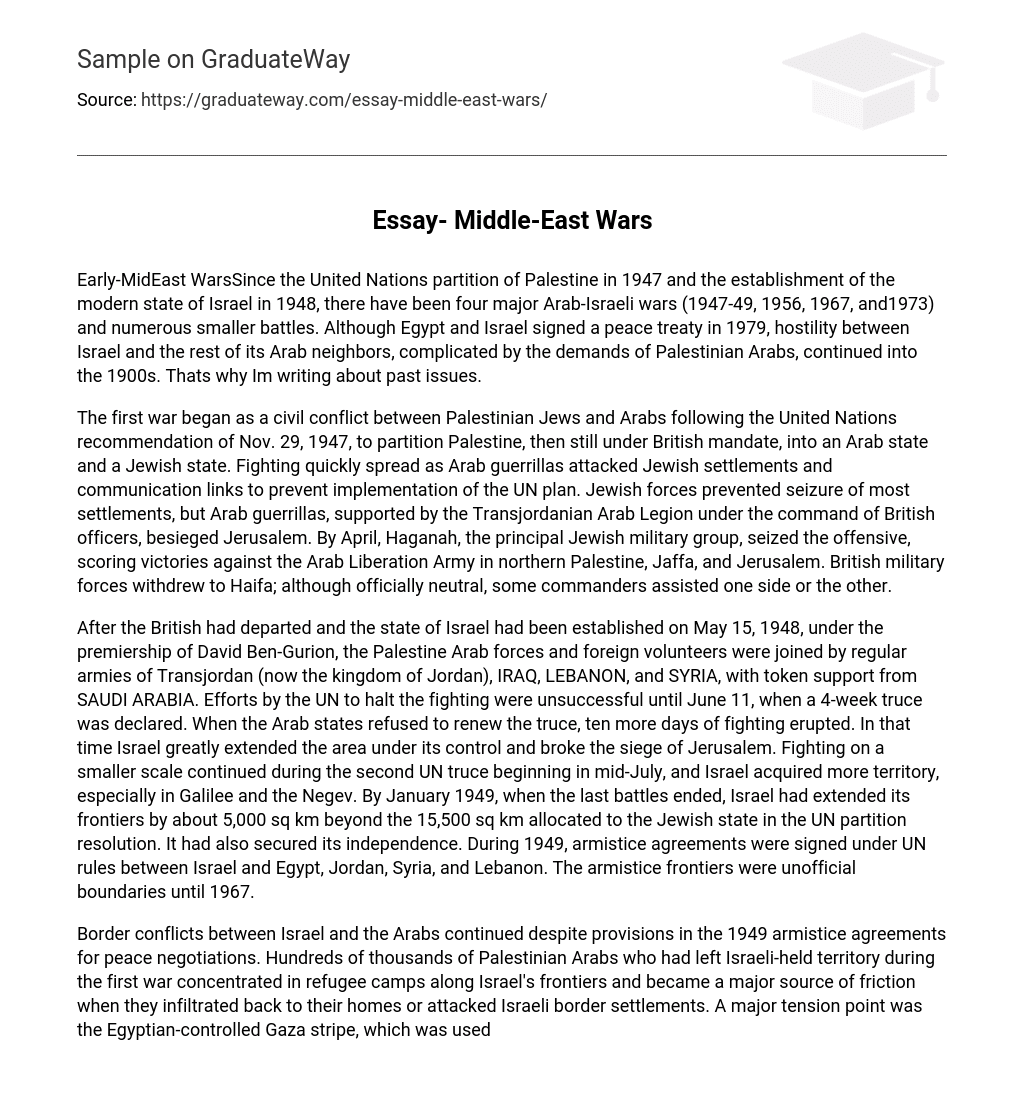Since the United Nations partition of Palestine in 1947 and the subsequent establishment of Israel in 1948, there have been four major Arab-Israeli wars (1947-49, 1956, 1967, and 1973) along with numerous smaller battles. Despite the signing of a peace treaty between Egypt and Israel in 1979, the animosity between Israel and its Arab neighbors has persisted into the current century due to ongoing demands from Palestinian Arabs.
Hence, I am addressing historical matters.
Initially, the first war started as an internal conflict between Palestinian Jews and Arabs. It was sparked by the United Nations’ proposal on November 29, 1947, to divide British-mandated Palestine into separate Arab and Jewish states. In order to prevent this UN suggestion from being implemented, Arab guerrillas began targeting Jewish settlements and causing disruptions in communication routes.
Jewish forces successfully stopped the capture of most settlements. However, Arab guerrillas, with the assistance of British officers commanding the Transjordanian Arab Legion, surrounded Jerusalem. In April, the Haganah, the main Jewish military group, took control and achieved victories over the Arab Liberation Army in northern Palestine, Jaffa, and Jerusalem. British military forces retreated to Haifa, with certain commanders secretly assisting either side despite being officially neutral.
After the British departure and the establishment of Israel on May 15, 1948 under David Ben-Gurion’s leadership, the Palestinian Arab forces and foreign volunteers were joined by the regular armies of Transjordan (now Jordan), Iraq, Lebanon, and Syria. Saudi Arabia provided minimal support. Despite UN’s unsuccessful efforts to halt it, the fighting persisted until June 11 when a four-week ceasefire was announced. However, after the Arab states declined to prolong the ceasefire, another ten days of conflict ensued.
During this period, Israel significantly expanded its territorial control and successfully lifted the blockade around Jerusalem. The fighting, although on a smaller scale, persisted during the second UN truce that began in mid-July. Consequently, Israel acquired more land, particularly in Galilee and the Negev region. By January 1949, when the final battles ended, Israel had increased its borders by approximately 5,000 square kilometers beyond the initially designated 15,500 square kilometers stated in the UN partition resolution. Additionally, Israel attained independence. Throughout 1949, armistice agreements were established under UN regulations between Israel and Egypt, Jordan, Syria, and Lebanon. These armistice boundaries did not gain official recognition until 1967.
Despite the provisions in the 1949 armistice agreements for peace negotiations, border conflicts between Israel and the Arabs persisted. The Palestinian Arabs, who had left Israeli-held territory during the first war, gathered in refugee camps along Israel’s frontiers and caused significant friction when they returned to their homes or launched attacks on Israeli border settlements. One particularly tense area was the Egyptian-controlled Gaza stripe, which served as a base for Arab guerrillas conducting raids into southern Israel.
Egypt’s blockade of Israeli shipping in the Suez Canal and Gulf of Aqaba heightened the conflict, further fueled by the Suez Crisis resulting from Egyptian President Gamal Nasser’s nationalization of the canal. Great Britain and France vehemently opposed Nasser’s actions, leading them to initiate a joint military campaign against Egypt. The expectation was for Israel to seize control of the Sinai Peninsula.
On October 29, 1956, Egypt, Syria, and Jordan announced their decision to join forces under the leadership of the Egyptian commander. This declaration marked the beginning of the war. Israel’s Operation Kadesh, led by Moshe Dayan, lasted less than a week. Within approximately 100 hours, Israeli forces efficiently seized control of the Gaza Strip and a significant portion of the Sinai Peninsula, advancing towards the eastern bank of the Suez Canal. Furthermore, on November 5th, Anglo-French troops invaded Egypt and gained dominion over the northern segment of the Suez Canal.
The UN General Assembly issued a resolution to end the war, which consisted of an immediate ceasefire and the withdrawal of occupying forces from Egypt. Additionally, the resolution created the United Nations Emergency Force (UNEF) to replace allied troops in Suez, Sinai, and Gaza on the Egyptian side. It took until December 22 for British and French troops to completely withdraw from Egypt. However, Israel did not depart right away as it sought assurances of security against future attacks. Eventually, Israel’s forces departed in March 1957 following additional UN resolutions and pressure exerted by the United States.
During the next ten years, Israel and Egypt had a consistent relationship. Israel was still unable to use the Suez Canal for shipping, and the Arab boycott against Israel continued. There were occasional border conflicts involving Israel, Syria, and Jordan. However, thanks to the United Nations Emergency Force, direct military confrontations between Egypt and Israel were prevented.
In 1967, Egypt, Syria, and Jordan became unhappy with the current situation. This led to increased propaganda against Israel and more border incidents. The tensions peaked in May when Egyptian forces gathered in Sinai. As a result, Cairo told the United Nations Emergency Force (UNEF) to leave Sinai and Gaza while President Nasser declared that Israeli ships would once again be banned from accessing the Gulf of Aqaba.
In May, a new defense pact was signed between Egypt and Jordan, resulting in the placement of Jordan’s armed forces under Egyptian command. Despite unsuccessful efforts to de-escalate the crisis, Israeli and Egyptian leaders visited the United States. During their visit, President Lyndon Johnson made an unsuccessful attempt to persuade Western powers to guarantee unrestricted passage through the Gulf.
In June 5, 1967, Israeli Premier Levi Eshkol, Minister of Defense Moshe Dayan, and Army Chief of Staff Yitzhak Rabin authorized Israeli attacks on the airfields of Egypt, Syria, Jordan, and Iraq. Their decision was based on their belief that war was inevitable. By the evening of June 6th, Israel had effectively eliminated the major Arab air forces by successfully destroying more than 400 planes while only losing 26 of their own aircraft. Additionally, Israel quickly advanced into Sinai and rapidly approached the Suez Canal. In less than four days, they managed to gain control over a majority portion of the peninsula.





